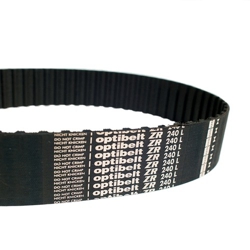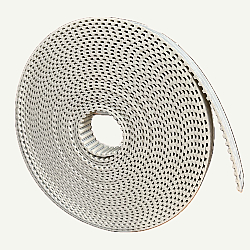We are your trusted source for high-quality classical timing belts in Australia. As a division of Naismith Engineering & Manufacturing Co Pty Ltd, we bring over seven decades of experience and expertise to the power transmission industry. Our commitment to excellence and extensive range of products make us a leading supplier of classical timing belts and related equipment across the country.
Read More
Features of Our Classical Belt
Classical timing belts, also known as trapezoidal tooth belts, are the original timing belt design and remain a popular choice in many industrial applications. Here are the key features that make our classical belts stand out:
- Trapezoidal Tooth Profile: The distinctive trapezoidal tooth shape provides a balance of strength and flexibility, ensuring reliable power transmission.
- High Tensile Strength: Our classical belts are reinforced with durable fiberglass cords, offering excellent load-bearing capacity and minimal stretch over time.
- Wear Resistance: The neoprene or polyurethane construction of our belts provides superior resistance to oil, heat, and abrasion, ensuring long-lasting performance.
- Precision Engineering: Each belt is manufactured to tight tolerances, ensuring consistent pitch and optimal meshing with pulleys for smooth, efficient operation.
- Noise Reduction: Compared to chain drives, our classical timing belts operate much more quietly, making them ideal for noise-sensitive environments.
- Low Maintenance: These belts require no lubrication and minimal tension adjustments, reducing maintenance time and costs.
- Wide Range of Sizes: We offer classical timing belts in a variety of pitches, widths, and lengths to suit diverse industrial applications.
- Temperature Resistance: Our belts are designed to perform reliably across a wide temperature range, from -30°C to +100°C, depending on the specific material.
The Cost of Classical Belt
The cost of a classical timing belt can vary based on several factors:
- Size and Length: Larger and longer belts generally cost more due to increased material usage.
- Material: Belts made from premium materials like polyurethane may be more expensive than standard neoprene belts.
- Reinforcement: Belts with higher-grade reinforcing cords for increased strength may come at a premium.
- Quantity: Bulk purchases often come with discounts, reducing the per-unit cost.
- Customisation: Custom-sized or specially treated belts may incur additional costs.
High-quality classical timing belts offer:
- Extended service life, reducing replacement frequency
- Improved system efficiency, potentially lowering energy costs
- Reduced downtime and maintenance needs
Remember, we offer free delivery on all orders over $75, providing additional value for your purchase.
Choosing the Right Classical Timing Belt
Selecting the correct classical timing belt is crucial for optimal performance and longevity. Here are key factors to consider:
- Pitch: This is the distance between belt teeth. Common pitches include 0.200 inch, 0.375 inch and 0.500 inch. Match this to your pulley specifications.
- Width: Belt width affects load capacity. Ensure the belt width matches your pulleys and meets your power transmission requirements.
- Length: Accurate measurement of the required belt length is essential for proper fit and tension.
- Load Requirements: Consider the power and torque that needs to be transmitted. This will influence the belt width and reinforcement needed.
- Speed: Higher speeds may require belts with special reinforcements or materials.
- Environmental Factors: Consider temperature, exposure to oils or chemicals, and other environmental conditions that might affect belt performance.
- Pulley Size: The number of teeth engaging with the pulley affects power transmission efficiency. Smaller pulleys may require belts with special flexibility.
Our team of experts is always ready to help you navigate these considerations and choose the perfect classical timing belt for your application.
Need Help?
Choosing and using the right classical timing belt can sometimes be challenging. That's why we're here to help. Our team of experts is ready to assist you in several ways:
- Product Selection: We can help you choose the right classical timing belt based on your specific needs, budget, and the types of equipment you're using.
- Technical Support: Our knowledgeable staff is available to answer any questions you might have about using or maintaining your classical timing belt.
- Customised Solutions: If you have unique power transmission challenges, we can work with you to find or develop a solution that meets your specific needs.
- Installation Advice: We can provide guidance on proper installation techniques to ensure optimal performance and longevity of your classical timing belt.
- Maintenance Tips: Learn best practices for maintaining your classical timing belts to extend their service life and maintain peak performance.
- Troubleshooting: If you're experiencing issues with your current timing belt system, we can help diagnose the problem and suggest solutions
FAQs
How long do classical timing belts typically last?
The lifespan varies depending on usage and conditions, but with proper installation and maintenance, they can often last several years.
Can classical timing belts be used in reverse rotation applications?
Yes, classical timing belts can typically handle bi-directional rotation without issues.
Are classical timing belts suitable for high-speed applications?
While they can be used in many high-speed applications, extremely high speeds may require special consideration. Consult with our experts for specific recommendations.
How do I know when it's time to replace my classical timing belt?
Signs include visible wear on the teeth, cracking, glazing on the belt surface, or unusual noise during operation. Regular inspections are recommended.




